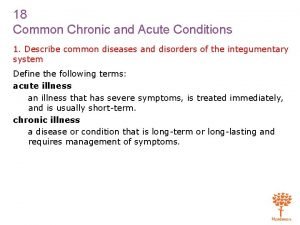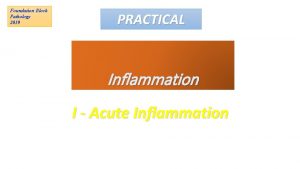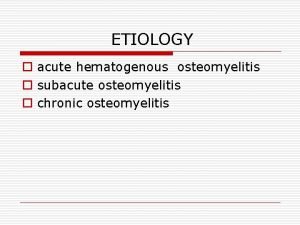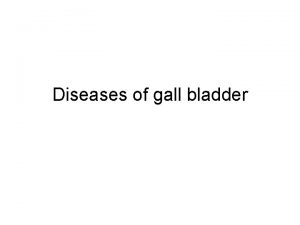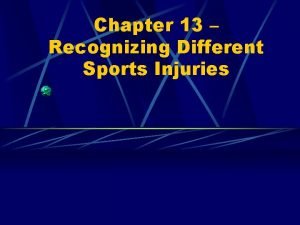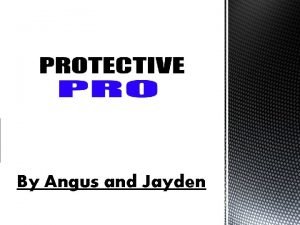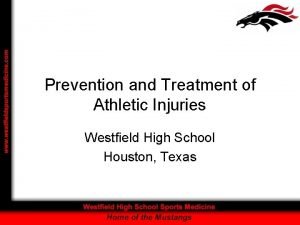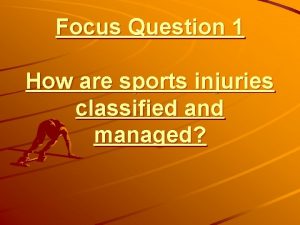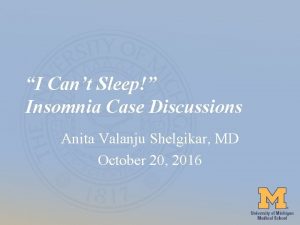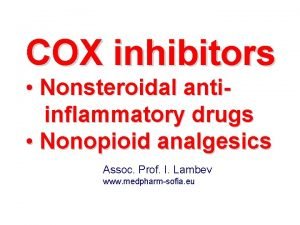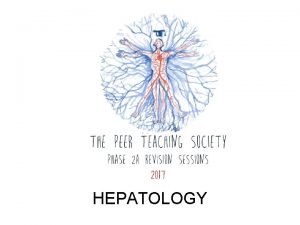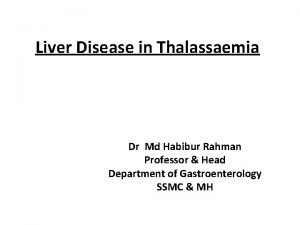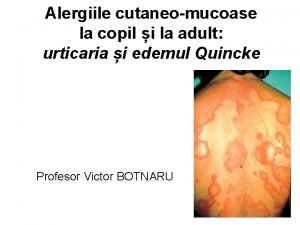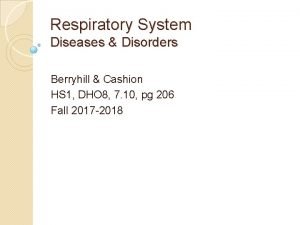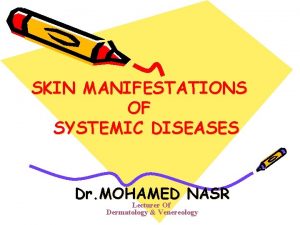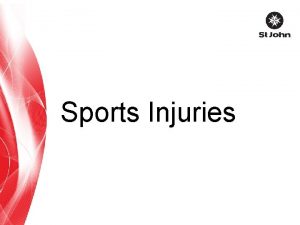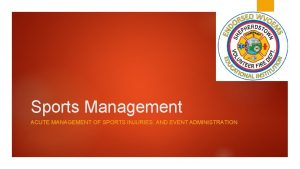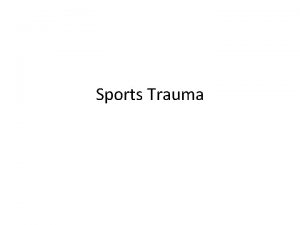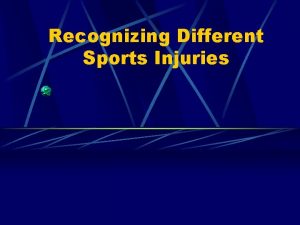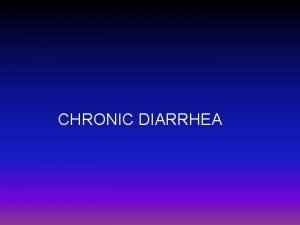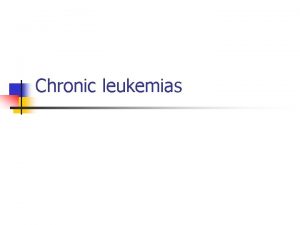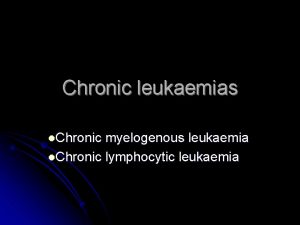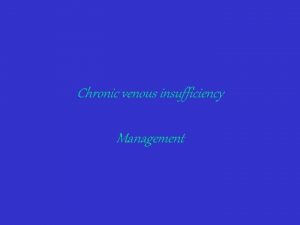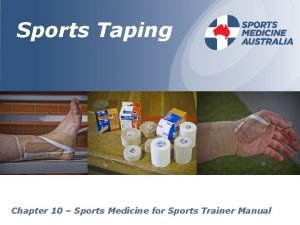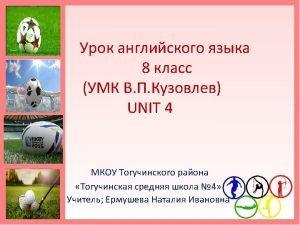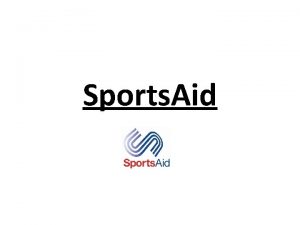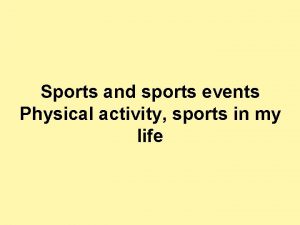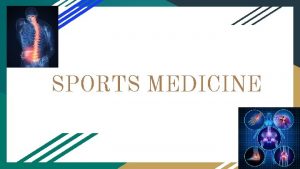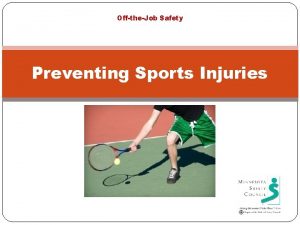Sports Injuries Acute v Chronic Injuries Acute injuries

























- Slides: 25

Sports Injuries

Acute v Chronic Injuries Acute injuries Injuries that occur quickly and for which pain and loss of function is immediate Chronic injuries Injuries that linger and affect performance over the longer term

Acute Examples Sprain Muscle strain Concussion Fracture Corky Dislocation

Chronic Examples Shin splints Osteitis pubis Tennis elbow Patellar tendonitis Stress fractures Achilles tendonitis

Hypothermia Core body temperature < 35 celsius Causes prolonged exposure to cold, wet Symptoms shivering, coordination loss, vagueness, irritability, slow pulse, shallow breathing, unconsciousness, possible death Treatment warm drinks, remove wet clothing, keep awake, exchange body heat

Hyperthermia (heat exhaustion) Causes exposure to hot, humid conditions especially whilst exercising and not drinking enough fluids (dehydration) Prevention not exercising in hot/humid conditions If must exercise rest in shade often, ice vests, increase hydration, light & loose clothing, acclimatise Youtube; ‘preventing sudden death in sport’

Asthma Narrowing of airways (bronchioles) restricts O 2 uptake Causes pollution, exercise, smoke, colds, dust Regular exercise can… reduce incidence and severity of attacks Asthmatics should… warm up, cool down, take medication before/during to prevent

DOMS (delayed onset muscle soreness) Usually 24 -48 hours post unaccustomed exercise especially eccentric exercises (running downhill, plyometrics, lowering weights small micro-tears in muscle fibre Reducing effects effective warm up, active cool down, stretching over 2448 hours Treatment RICERS, anti inflammatory drugs, ultrasound, gentle eccentric exercise

Overtraining Physiological symptoms Symptoms that result from body stressors Psychological symptoms Symptoms that result from mind stressors

Overtraining Causes Amount and recovery time is insufficient to fully recover from stresses of training Excessive training volume Too much training overload Working too hard too soon after injury Excessive competition scheduling Poor nutritional state External stressors such as work, study, family, relationships

Physiological Symptoms Persistent fatigue Chronic muscle soreness Increased or decreased morning heart rate Increased heart rate during sub maximal exercise Decreased performance of strength, power and co ordination

Psychological Symptoms Decreased concentration Decreased motivation Depression Increased irritability, anger, anxiety, fear of competition, sensitivity to emotional stress

Miscellaneous Symptoms Frequent illness Loss of appetite Increase in overuse injuries Insomnia Lack of enjoyment of training and competition

Sports Injuries Classification and Management

Draw lines to match the type of injuries with the description and examples. Type of Injury Description Example Direct When the body makes contact with an external object, for example another person, object, or the ground. When you dislocate your finger if it is hit on the end by a ball Indirect Is caused by forces inside the body, such as excessive strain on the muscles and ligaments When you strain your hamstring whilst sprinting Overuse When specific body regions are used over periods of time, particularly when the movements are repetitive and lowimpact Shin splints from running on the concrete every day. Soft tissue injury An injury to any tissue except bone and teeth A muscular tear or blister on the skin Hard tissue injury Injuries to bone and teeth A broken rib from a hard football tackle

Complete the table on skin injuries by filling in the blank spaces Type of skin injury Description Example Skin abrasion When the surface layer of the skin is broken. They usually cause pain and shallow bleeding as a result of skin scraping. A graze caused by falling down on asphalt at netball Laceration Where there is damage to the skin and to the underlying tissue A boxer’s eye lid is split open from a punch Blisters Where the outer layer of skin separates due to friction, which causes a pocket of fluid or blood to form Your shoes rub on the heel of your foot causing a pocket of fluid to form under the skin. Calluses Result from a build up of dead skin caused by frequent rubbing or pressure. When you get hard skin on the bottom of your foot from constantly changing direction in netball.

3. Describe a muscular injury. Muscular injuries occur when the muscle, tendon or ligament soft tissue in the body is damaged. 4. Compare a muscular sprain to a muscular strain. When a ligament in the body is injured it’s called a sprain. A strain, on the other hand, is an injury to the muscles and tendons of the body. 5. Identify the symptoms of a muscular sprain. Symptoms will include pain, particularly at the end of the range of movement, swelling and instability.

Complete the table showing the different levels of muscular tear. Grade 1 Grade 2 Grade 3 When you just have a tear of a few fibres in the muscle There is more damage to a significant number of fibres. When you get a complete tear of a muscle There will be pain on stretch, but no less strength when you test that muscle for strength. There will be a reduction in strength You can feel the tear within the muscle There’ll be mild pain, but not severe pain. There will be pain on stretch of that muscle More severe pain Limited movement

7. Explain the term contusion and give a practical example A contusion (or bruise) occurs when an athlete collides with an external object, causing local muscular damage. This can result in pain, swelling and heat at the injury site. e. g. when a player collides with another player and they get a corked thigh. 8. Explain the purpose of the inflammatory response to soft tissue injuries. The purpose of this response is to defend against harmful substances and infection, dispose of dead tissue caused by the injury, and to promote the renewal process.

Phase Description Acute inflammatory phase You also get some white blood cells, the inflammatory cells, which are aiding in the response phase of healing Fibreblasts move from the blood vessels to the tissue, to initiate the healing. Remodelling phase Damage of the capillary allows inflammatory cells to flood out of the blood vessels into the ligamentous tissue. This brings macrophages – cells – which are there to eat away the debris from the damaged cells that have occurred due to injury. Proliferation or Healing Phase Symptoms The fibreblasts start to build the scar matrix, and collagen is repaired. The body will send blood to the area The area will become red, swollen and warm. This stage lasts for 42 -72 hours. This phase can occur within 48 hours to 6 weeks after the injury up to 3 months or longer the tissues will expand causing pressure on the nerves The area will be painful. Scar tissue build up Thickening of the ligament or tendon The ligament is remodeled, with increased production of scar tissue and strengthening and development of the replacement tissue. Time Ligament or tendon gradually comes down to its old size Increase strength

Identify and outline the terms related to the Acronym RICER. R = Rest I = Ice C = compression E = Elevation R = Referral

Q 11 Define the following types of hard tissue injuries: Complete fracture is where the bone snaps in two or more parts. Incomplete fracture is where the bone is cracked, but not completely broken into two separate pieces. Simple fractures are when the bone is cleanly broken, without breaking through the skin. Complex or compound fracture. Compound fractures occur where a bone breaks through the skin, causing an open wound. Dislocations usually occur at unstable joints that allow for a wide range of movement, for example shoulder, knee and finger joints.

12. Identify the two important procedures for hard tissue injuries. Immobilisation Splinting 13. Outline the procedures for a tooth dislocation. If the tooth has been dislodged you need to put it back into place and splint it to the adjacent tooth using aluminium foil. If this is not possible, place the tooth in milk or saliva.

14. In what situation would you use the DRABC regime? Outline the procedures used If the situation may be life-threatening, you need to go through the DRABC checklist. DRABC provides a systematic routine for checking for danger, response, airways, breathing and circulation. Danger = if they’re still in any chance of being in danger you must remove that danger away from them. Response = where you talk to that person – can you hear me? What is your name? Airway = make sure their airways are clear. If someone is unconscious then they lose their gag reflex and their tongue can then block their airways. This is a possibility in a situation where they’ve cause to vomit or something else is blocking their airway Breathing = look at the chest and see if the chest is moving up and down and listen to see if we can hear them breathing. If there is no breathing give 2 rescue breaths. Compressions = If there is still no breathing start CPR. 2 breaths and 30 compressions and call for ambulance. If they are breathing, place in the recovery position and attend to other injuries. Bleeding first, then bone.

15. In what situation would you use the TOTAPS regime? Outline the procedures If the injury is not life-threatening, the TOTAPS procedure can be used to provide a detailed injury assessment. TOTAPS stands for talk, observe, touch, active movement, passive movement and skills. Talk= the first thing you do is ask them about the injury. Where is your pain? What are you feeling? What happened to give you this pain? If you get an idea of the injury and the way it happens, it leads you more easily towards a diagnosis. Observe = Look for abnormalities; redness, bruising or bleeding. Compare to the other side of the body. If they’ve broken their leg and it’s a compound fracture, you’re going to see the bone coming through the skin. Touch = Touch area to check for swelling and abnormalities as well as sensitivity to pain. Active movement = If the injury isn’t so bad then you can ask them to move the injured area. Are they able to move it without pain? Passive movement = If they’re able to move it without pain then do some passive movement so you can over-press and feel how well the knee is moving. Skills = If the injury doesn’t seem bad, then get the athlete up and have them walk first, and then jog. If they’re able to do this without too much pain, and then you can test their skills and how well they’re able to move. It may be possible for the athlete to continue on with the sport or they may need to stop immediately, come off the ground, and you start your RICER regime.
 Leukemia survival rate
Leukemia survival rate Cardinal signs of inflammation
Cardinal signs of inflammation 18 common chronic and acute conditions
18 common chronic and acute conditions Apical periodontitis
Apical periodontitis Acute cholecystitis vs chronic cholecystitis
Acute cholecystitis vs chronic cholecystitis Acute inflammation morphology
Acute inflammation morphology Acute subacute chronic
Acute subacute chronic Acute vs chronic heart failure
Acute vs chronic heart failure Cholecystitis
Cholecystitis Chapter 13 worksheet recognizing different sports injuries
Chapter 13 worksheet recognizing different sports injuries Sports injuries angus, on
Sports injuries angus, on Westfield sports injuries
Westfield sports injuries How are sports injuries classified and managed
How are sports injuries classified and managed Chapter 11 assessment and evaluation of sports injuries
Chapter 11 assessment and evaluation of sports injuries Now group these activity into indoor and outdoor activities
Now group these activity into indoor and outdoor activities Chronic insomnia
Chronic insomnia Ocular allergies icd 10
Ocular allergies icd 10 Chronic gout
Chronic gout Chronic
Chronic Phases of chronic hepatitis b
Phases of chronic hepatitis b Chronic disease
Chronic disease Stigmata of chronic liver disease
Stigmata of chronic liver disease Chronic inducible urticaria
Chronic inducible urticaria Clindamcin
Clindamcin Chronic bronchitis
Chronic bronchitis Earthy look in chronic renal failure
Earthy look in chronic renal failure


